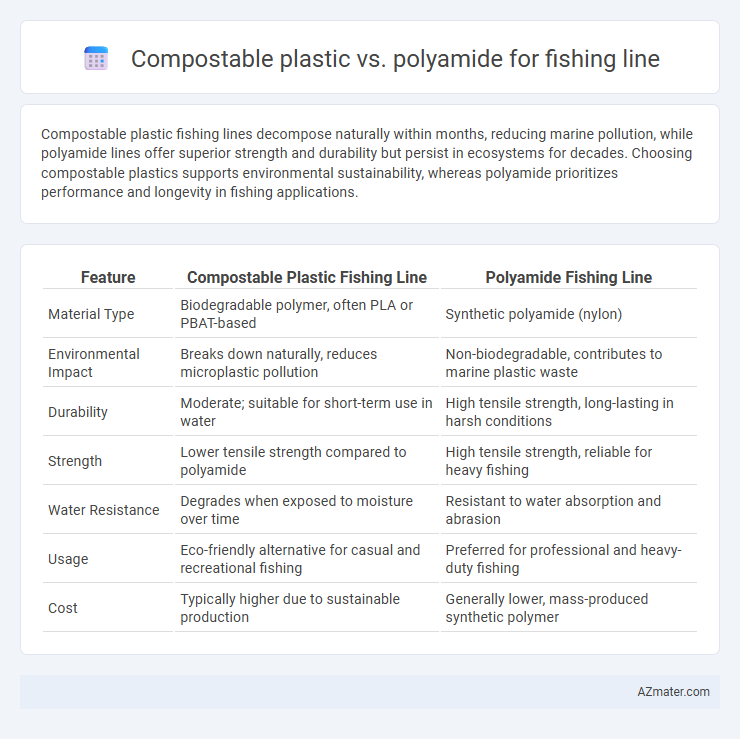Compostable plastic fishing lines decompose naturally within months, reducing marine pollution, while polyamide lines offer superior strength and durability but persist in ecosystems for decades. Choosing compostable plastics supports environmental sustainability, whereas polyamide prioritizes performance and longevity in fishing applications.
Table of Comparison
| Feature | Compostable Plastic Fishing Line | Polyamide Fishing Line |
|---|---|---|
| Material Type | Biodegradable polymer, often PLA or PBAT-based | Synthetic polyamide (nylon) |
| Environmental Impact | Breaks down naturally, reduces microplastic pollution | Non-biodegradable, contributes to marine plastic waste |
| Durability | Moderate; suitable for short-term use in water | High tensile strength, long-lasting in harsh conditions |
| Strength | Lower tensile strength compared to polyamide | High tensile strength, reliable for heavy fishing |
| Water Resistance | Degrades when exposed to moisture over time | Resistant to water absorption and abrasion |
| Usage | Eco-friendly alternative for casual and recreational fishing | Preferred for professional and heavy-duty fishing |
| Cost | Typically higher due to sustainable production | Generally lower, mass-produced synthetic polymer |
Introduction to Sustainable Fishing Lines
Compostable plastic fishing lines offer an eco-friendly alternative designed to break down naturally in marine environments, reducing wildlife entanglement and plastic pollution. Polyamide fishing lines, known for their high strength and abrasion resistance, are widely used but pose long-term environmental risks due to their non-biodegradable nature. Sustainable fishing lines prioritize materials that minimize ecological impact while maintaining performance, promoting marine conservation and responsible fishing practices.
What is Compostable Plastic Fishing Line?
Compostable plastic fishing lines are made from biodegradable materials such as polylactic acid (PLA) or starch-based polymers designed to break down naturally in the environment, reducing long-term pollution in aquatic ecosystems. Unlike traditional polyamide (nylon) lines, which persist for years and contribute to microplastic pollution, compostable lines decompose within months under proper composting conditions, minimizing harm to marine life. The shift to compostable plastic fishing lines supports sustainable fishing practices by offering an eco-friendly alternative that balances performance with environmental responsibility.
Understanding Polyamide (Nylon) Fishing Line
Polyamide (Nylon) fishing lines are renowned for their exceptional strength, flexibility, and abrasion resistance, making them a preferred choice for many anglers. Unlike compostable plastics, which prioritize environmental degradation, nylon's durability ensures reliable performance and longevity in harsh aquatic conditions. Understanding the balance between sustainability and functionality is key when selecting fishing lines for specific fishing environments.
Environmental Impact: Compostable Plastic vs Polyamide
Compostable plastic fishing lines break down naturally within months under industrial composting conditions, significantly reducing marine pollution compared to polyamide lines, which persist for decades in aquatic environments. Polyamide fishing lines release toxic microplastics and chemical additives that harm marine ecosystems and bioaccumulate in the food chain. The use of compostable plastics mitigates long-term ecological damage by promoting biodegradation, thus supporting ocean health and reducing plastic debris accumulation.
Durability and Performance in Fishing Applications
Compostable plastic fishing lines offer eco-friendly disposal benefits but generally lack the durability and abrasion resistance compared to polyamide lines, which provide superior strength and longevity in harsh marine environments. Polyamide, commonly known as nylon, maintains high tensile strength and resilience under repeated stress, making it ideal for challenging fishing conditions, whereas compostable plastics tend to degrade faster and may compromise performance during extended use. Choosing polyamide lines ensures reliable performance and reduced line breaks, critical for successful fishing applications.
Biodegradability and Decomposition Rates
Compostable plastic fishing lines, derived from plant-based polymers like polylactic acid (PLA), exhibit higher biodegradability compared to conventional polyamide lines, breaking down into non-toxic components within months under industrial composting conditions. Polyamide fishing lines, made from synthetic nylon, resist decomposition and can persist in aquatic environments for decades, contributing to microplastic pollution and posing hazards to marine life. The rapid decomposition rates of compostable plastics reduce environmental impact, making them a more sustainable choice for fishing applications aiming to mitigate marine debris.
Cost Comparison and Market Availability
Compostable plastic fishing lines generally incur higher production costs due to specialized biodegradable materials, resulting in prices up to 30% above conventional polyamide lines. Polyamide, widely available in global markets, dominates fishing line production owing to its cost-effectiveness and robust supply chain infrastructure. Limited manufacturing facilities for compostable plastics restrict market availability, making polyamide a more accessible and economical choice for anglers worldwide.
Effects on Marine Life and Ecosystems
Compostable plastic fishing lines break down more rapidly in marine environments, reducing long-term entanglement risks and microplastic pollution, which benefits marine life and ecosystems. Polyamide fishing lines, known for their durability and strength, persist much longer in water, contributing to ghost fishing and habitat damage. The faster degradation of compostable plastics minimizes harm to marine organisms and supports healthier ocean ecosystems.
Angler Preferences and User Experiences
Anglers often prefer polyamide fishing lines due to their superior strength, abrasion resistance, and reliable performance in diverse water conditions compared to compostable plastics. User experiences highlight polyamide's durability and consistent casting distance, whereas compostable fishing lines appeal to environmentally conscious anglers seeking biodegradability despite slightly reduced tensile strength and durability. The balance of performance and ecological impact drives angler preferences, with many prioritizing reliable catch rates and line longevity in demanding fishing environments.
Future Trends in Eco-Friendly Fishing Lines
Compostable plastics are gaining traction as sustainable alternatives to traditional polyamide fishing lines due to their biodegradable properties that reduce long-term marine pollution. Innovations in bio-based polymers and enzyme-enhanced compostable materials are driving future trends toward fishing lines that maintain strength while minimizing environmental impact. Industry forecasts predict increased regulatory support and consumer demand for eco-friendly fishing lines, promoting the development of hybrid composites combining polyamide durability with compostable elements.

Infographic: Compostable plastic vs Polyamide for Fishing line
 azmater.com
azmater.com